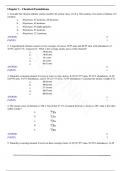Chapter 1 - Chemical Foundations
1. Consider the element indium, atomic number 49, atomic mass 114.8 g. The nucleus of an atom of indium-112
contains:
a. 49 protons, 63 neutrons, 49 electrons.
b. 49 protons, 49 neutrons.
c. 49 protons, 49 alpha particles.
d. 49 protons, 63 neutrons.
e. 49 protons, 112 neutrons.
ANSWER: d
POINTS: 1
2. A hypothetical element consists of two isotopes of masses 78.95 amu and 80.95 amu with abundances of
32.9% and 67.1%, respectively. What is the average atomic mass of this element?
a. 79.95 amu
b. 78.95 amu
St
c. 79.6 amu
d. 80.3 amu
e. 80.95 amu
ANSWER: d
ud
POINTS: 1
3. Naturally occurring element X exists in three isotopic forms: X-28 (27.977 amu, 92.23% abundance), X-29
(28.976 amu, 4.67% abundance), and X-30 (29.974 amu, 3.10% abundance). Calculate the atomic weight of X.
a. 28.09 amu
yN
b. 48.63 amu
c. 27.16 amu
d. 28.97 amu
e. 86.93 amu
ANSWER: a
es
POINTS: 1
4. The atomic mass of rhenium is 186.2. Given that 37.1% of natural rhenium is rhenium-185, what is the other
stable isotope?
a.
t
b.
c.
d.
e.
ANSWER: b
POINTS: 1
5. Naturally occurring element X exists in three isotopic forms: X-28 (27.977 amu, 92.23% abundance), X-29
,Chapter 1 - Chemical Foundations
(28.976 amu, 4.67% abundance), and X-30 (29.974 amu, 3.10% abundance). What is the identity of element X?
a. Cu
b. Al
c. Ni
d. Si
e. Sr
ANSWER: d
POINTS: 1
6. What is the mass of 6 atom(s) of copper in grams?
a. 381.3 g
b. 1.58 × 1021 g
c. 6.38 × 10–24 g
d. 6.022 × 1023 g
St
e. 6.33 × 10–22g
ANSWER: e
POINTS: 1
ud
7. You have a sample of zinc (Zn) and a sample of aluminum (Al). You have an equal number of atoms in each
sample. Which of the following statements concerning the masses of the samples is true?
a. The mass of the zinc sample is more than twice as great as the mass of the aluminum sample.
b. The mass of the zinc sample is more than the mass of the aluminum sample, but it is not twice as great.
c. The mass of the aluminum sample is more than twice as great as the mass of the zinc sample.
yN
d. The mass of the aluminum sample is more than the mass of the zinc sample, but it is not twice as great.
e. The masses of each sample are equal.
ANSWER: a
POINTS: 1
es
8. has .
a. 20 protons, 20 neutrons, and 18 electrons
b. 22 protons, 20 neutrons, and 20 electrons
c. 20 protons, 22 neutrons, and 18 electrons
t
d. 22 protons, 18 neutrons, and 18 electrons
e. 20 protons, 20 neutrons, and 22 electrons
ANSWER: a
POINTS: 1
9. Which of the following statements is (are) true?
a.
and have the same number of neutrons.
b.
and are isotopes of each other because their mass numbers are the same.
,Chapter 1 - Chemical Foundations
c.
has the same number of electrons as .
d. A and B
e. A and C
ANSWER: e
POINTS: 1
10. A species with 12 protons and 10 electrons is .
a. Ne2+
b. Ti2+
c. Mg2+
St
d. Mg
e. Ne2–
ud
ANSWER: c
POINTS: 1
11. The numbers of protons, neutrons, and electrons in K+ are:
yN
a. 20 p, 19 n, 19 e.
b. 20 p, 19 n, 20 e.
c. 19 p, 20 n, 20 e.
d. 19 p, 20 n, 19 e.
es
e. 19 p, 20 n, 18 e.
ANSWER: e
POINTS: 1
12. An ion is formed:
t
a. by either adding or subtracting protons from the atom.
b. by either adding or subtracting electrons from the atom
c. by either adding or subtracting neutrons from the atom.
d. all of the above are true.
e. two of the above are true.
ANSWER: b
POINTS: 1
13. All of the following are true except:
a. ions are formed by adding electrons to a neutral atom.
b. ions are formed by changing the number of protons in an atom's nucleus.
, Chapter 1 - Chemical Foundations
c. ions are formed by removing electrons from a neutral atom.
d. an ion has a positive or negative charge.
e. metals tend to form positive ions.
ANSWER: b
POINTS: 1
14. The formula of water, H2O, suggests:
a. there is twice as much mass of hydrogen as oxygen in each molecule.
b. there are two hydrogen atoms and one oxygen atom per water molecule.
c. there is twice as much mass of oxygen as hydrogen in each molecule.
d. there are two oxygen atoms and one hydrogen atom per water molecule.
e. none of these.
ANSWER: b
St
POINTS: 1
15. NaHCO3 is the active ingredient in baking soda. How many grams of oxygen are in 0.33 g of NaHCO3?
a. 0.063 g
ud
b. 0.012 g
c. 3.93 × 103 g
d. 0.021 g
e. 0.19 g
yN
ANSWER: e
POINTS: 1
16. Phosphorus has the molecular formula P4, and sulfur has the molecular formula S8. How many grams of
phosphorus contain the same number of molecules as 4.26 g of sulfur?
es
a. 2.06 g
b. 0.486 g
c. 4.11 g
d. 4.26 g
e. none of these
t
ANSWER: a
POINTS: 1
17. What is the subscript of barium in the formula of barium phosphate?
a. 3
b. 4
c. 1
d. 0
e. 2
ANSWER: a




